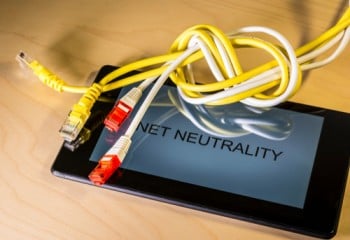Senate votes to save net neutrality; resolution faces uphill battle in the House

Shutterstock.com.
The Senate on Wednesday voted to reverse the Federal Communications Commission’s decision to end net neutrality.
However, to keep the Obama-era rules, the House of Representatives will need to follow suit and President Donald Trump will need to sign the resolution before June 11, when the agency’s new rules are scheduled to go into effect.
The Senate vote was notably bipartisan with all 49 Democratic caucus members and three Republicans voting in favor of the resolution. The Republicans were Sens. Susan Collins of Maine, John Kennedy of Louisiana and Lisa Murkowski of Alaska.
The sponsors of the resolution in the Senate used the Congressional Review Act, which allows Congress to turn back administrative agency decisions within a certain period of time. The same power was used widely at the beginning of the current Congress to reverse late-term decisions by the Obama administration.
Citing that one in five Louisianans do not have a choice over their internet service provider, Sen. Kennedy told the Washington Post that his vote “was a fairly close call, but I’ll tell you what it comes down to: The extent to which you trust your cable company. If you trust your cable company, you’re not going to like my vote today. If you don’t trust your cable company, you will.”
In December, the FCC repealed the net neutrality rules. Originally passed in 2015 and upheld by the U.S. Court of Appeals for the D.C. Circuit in 2016, the rules required that internet service providers like AT&T, Comcast and Verizon treat all web traffic equally. This meant that, for example, providers would not be allowed to “throttle” or change the speed with which a person accesses a website. The repeal allows ISPs to block or slow some online traffic. In other cases, the provider can negotiate with a website for “fast lanes” to users.
Going further than just repealing the rules, the agency said it did not have the legal authority used in 2015 to regulate internet providers. The FCC is led by Trump appointee Ajit Pai.
The battle over these rules were heated and partisan, the final FCC vote for repeal was 3–2, along party lines.
A path forward for the resolution in the House is unclear. Matthew Sparks, a spokesman for House Majority Leader Kevin McCarthy of California, would not tell the Post if the House would take up the CRA, but mentioned that the body was working on a separate bill “to permanently address” net neutrality.
Some, however, see the vote as less about stopping the current policy from going into effect and more about this fall’s midterm elections.
“The Senate vote, on the eve of midterms, could have significant political effects,” said Marc Martin, a telecom lawyer at Perkins Coie in Washington, told the Post on Wednesday.
A poll from Program for Public Consultation at the University of Maryland last December showed bipartisan support for the 2015 net neutrality rules at 83 percent.
However, as Martin points out, it is not clear how many voters this fall will prioritize this issue over a flurry of others.



